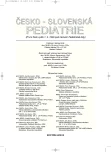Oneskorený nástup puberty a znížený rast ako prvé príznaky Swyerovho syndrómu?
:
L. Šabová 1; Z. Blusková 1; D. Virgová 2; V. Cingel 3; J. Porubský 4; Ľ. Košťálová 1
:
II. detská klinika LFUK a DFNsP, Bratislava
prednosta prof. MUDr. L. Kovács, DrSc., MPH
1; Pediatricko-neonatologické oddelenie NsP Levice, n. o.
primárka MUDr. D. Virgová
2; Klinika detskej chirurgie LFUK a DFNsP, Bratislava
prednosta doc. MUDr. J. Trnka, CSc.
3; Ústav patologickej anatómie LFUK, Bratislava
prednosta prof. MUDr. Ľ. Danihel, PhD.
4
:
Čes-slov Pediat 2010; 65 (3): 110-116.
:
Case Report
Ide o pacientku odoslanú na vyšetrenie do endokrinologickej ambulancie vo veku 15 rokov pre znížený rast a nenastupujúcu pubertu. Habitus dieťaťa vrátane vonkajšieho genitálu bol dievčenský. V ultrasonografii a MRI malej panvy sa jednoznačne nezobrazili ováriá, bola popísaná len prítomnosť uteru. Laboratórne sa zistili vysoké hladiny gonadotropínov LH aj FSH a nízky estradiol a testosterón, v genetickom vyšetrení karyotyp 46,XY. Laparoskopia dokázala hypoplastický uterus a na oboch stranách štruktúry túb a paratubárnych tkanív. Tkanivo ovárií ani testes sa nepotvrdilo ani histologicky.
Na základe vyšetrení sa stanovila diagnóza Swyerovho syndrómu (čistá gonadálna dysgenéza), ktorý patrí do skupiny porúch sexuálnej diferenciácie. U pacientky sa navodzuje puberta malými dávkami estrogénov a pre znížený rast, ktorý bol na podklade SGA (dieťa narodené malé vzhľadom na gestačný vek), je liečená rastovým hormónom.
Kľúčové slová:
Sweyerov syndróm, čistá gonadálna dysgenéza, znížený vzrast, oneskorený nástup puberty
Sources
1. Hughes IA, Houk C, Ahmed SF, Lee PA. Lawson Wilkins Pediatric Endocrine Society/European Society for Paediatric Endocrinology Consensus Group. Consensus statement on management of intersex disorders. J. Pediatr. Urol. 2006; 2(3): 148–162.
2. Lisá L. Poruchy gonád na genetickém podkladě. In: Lisá L, Seemanová E, Zuntová A. Poruchy funkce gonád. Praha: Triton, 2004: 11–93.
3. Behtash N, Karimi Zarchi M. Dysgerminoma in three patients with Swyer syndrome. Wld J. Surg. Oncol. 2007; 5: 71.
4. Marchina E, Gambera A, Spinelli E, et al. Identification of a new mutation in the SRY gene in a 46,XY woman with Swyer syndrome. Fertil. Steril. 2008; 91(3): 932.
5. Seemanová E. Poruchy gonadálního a pohlavního vývoje – gonadální dysgeneze v důsledku genetické mutace. In: Lisá L, Seemanová E, Zuntová A. Poruchy funkce gonád. Praha: Triton, 2004: 95–120.
6. Pleskačová J, Šnajderová M, Lebl J. Disorders of sex differentiation: genes responsible for development of genital system and final phenotype. Čes. Gynekol. 2009; 74(3): 192–197.
7. Gemelli G, Gemelli S, Dimasi N, et al. Identification and molecular modeling of a novel familial mutation in the SRY gene implicated in the pure gonadal dysgenesis. Eur. J. Hum. Genet. 2007; 15(1): 76–80.
8. Stoicanescu D, Belengeanu V, Amzar D, et al. Complete gonadal dysgenesis with XY chromosomal constitution. Acta Endocrinol. 2006; 2(4): 465–470.
9. Tagliarini EB, Assupcao JG, Scolfaro MR, et al. Mutations in SRY and WT1 genes required for gonadal develepment are not responsible for XY partial gonadal dysgenesis. Braz. J. Med. Biol. Res. 2005; 38(1): 17–25.
10. Feit JP, David M, de Peretti E, Chopard A, Forest M, Jeune M. XY pure gonadal dysgenesis. Two cases report. Arch. Fr. Pediatr. 1980; 37(2): 111–112.
11. Tsutsumi O, Iida T, Taketani Y, Sugase M, Nakahori Y, Nakagome Y. Intact sex determining region Y (SRY) in a patient with XY pure gonadal dysgenesis and a twin brother. Endocr. J. 1994; 41(3): 281–285.
12. Sills IN, Rapaport R, Skuza KA, Horlick MN. 46,XX pure gonadal dysgenesis with growth hormone deficiency and impaired 3 beta-hydroxysteroid dehydrogenase activity. Am. J. Med. Genet. 1992; 42(1): 100–103.
13. Lisá L. Disorders of sexual differentiation and sexual development. Čes.-slov. Pediat. 1992; 47(11): 673–677.
14. Cools M, Drop SLS, Wolffenbuttel KP, et al. Germ cell tumors in the intersex gonad: Old paths, new directions, moving frontiers. Endocr. Rev. 2006; 27(5): 468–484.
15. Kříž J. Poruchy sexuální diferenciace. Urol. List. 2007; 5(1): 12–15.
16. Zielinska D, Zajaczek S, Rzepka-Górska I. Tumors of dysgenetic gonads in Swyer syndrome. J. Pediatr. Surg. 2007; 42(10): 1721–1724.
17. Hermus R, de Leeuw BH, Wolffenbuttel KP, et al. New insights into type II germ cell tumor pathogenesis based on studies of patients with various forms of disorders of sex development (DSD). Mol. Cell Endocrinol. 2008; 291(1–2): 1–10.
18. Mazanec K, Vorechovský I. Histopathology of gonads in syndromes of abnormal sexual differentiation. Čes. Patol. 1989; 25(1): 54–60.
19. Michala L, Goswami D, Creighton SM, et al. Swyer syndrome: presentation and outcomes. BJOG 2008; 115(6): 737–741.
Labels
Neonatology Paediatrics General practitioner for children and adolescentsArticle was published in
Czech-Slovak Pediatrics

2010 Issue 3
Most read in this issue
- Lactose Intolerance
- Acute Injury in Children – Therapy and Prognosis
- Delayed Puberty Onset and Short Stature as First Signs of Swyer’s Syndrome?
- Natal and Neonatal Teeth
